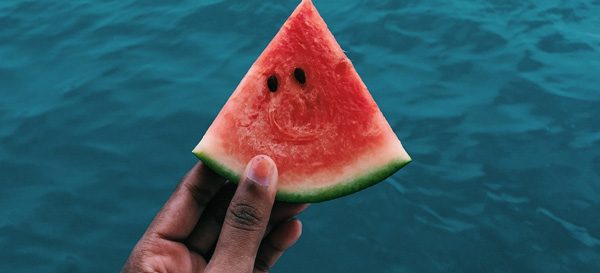5 Foods to Avoid Summer Dehydration

After a long day at work or an intense session at the gym, the only thing that we ever want is a tall glass of water with many ice cubes. On instinct, our body craves for water even more than food – after all, 80% of us are made of water! It is always an important reminder to stay hydrated and drink water regularly, as it could be very easy to ignore your body’s thirst when you focus too much on work and study.
When the body enters the state of thirst, it tries extremely hard to retain as much water as possible, resulting in swelling. In severe cases, you can get headaches and sluggishness (yes, you could feel tired and sleepy when you do not drink enough water). And most of us realize that we are dehydrated when it is too late, and we feel headaches, nausea, and dizziness. Another sign of dehydration is found in the color of urine – the darker it is, the more your body needs water, and you have forgotten to drink enough.
However, the tastelessness of water turns people away; they would rather have a large smoothie, or an iced frappuccino – anything other than plain drinking water! Most of the times, the calories in the smoothies and frappuccinos outweigh the calories lost during the day and during your hard workouts. So, all your efforts to lose weight might be in vain.
Luckily, there are plenty of other alternatives, which are both healthy and satisfying, to replace all those unhealthy foods and still provide hydration to our body. Plenty of research shows that, by getting water-rich foods in your diet, you do not only reach the recommended water intake, but you also fill up your stomach, and as a result, you eat less and lose more weight!
This article discusses the top 5 foods you should eat, along with drinking water, to get the required water intake per day.
1. Watermelon
Remember all the summer days when our fathers worked in the garden, you played with your pets, and mothers prepared the freshest watermelon slices? Watermelon is surely a familiar treat for all of us after a long day because it is an excellent hydrating fruit.
This summer staple is originally a tropical type of fruit, but nowadays different varieties of watermelon are being cultivated everywhere in the world. They all share the same red, juicy and sweet flesh and hard green outer rind, making them ideal to be held by hand and savor. For each watermelon, water makes up 91% of the content, and sugar is present at 6%. With such a high level of water and low level of salt and sugar, watermelons are sure to satisfy the thirst of even the most difficult people.
Below is a simple to follow instruction on a watermelon water detox for hot summer days:
- 4 cups of cubed watermelon
- 2 liters of water
- ½ lemon, sliced
- ½ lime, sliced
- ¼ cup fresh mint leaves
Directions:
- Cut the watermelon into cubes.
- Add them along with slices of lime and lemon into your favorite water container.
- Fill them with cool drinking water.
- Lastly, put the mint leaves in and shake the container well. Serve cold in glasses.
2. Celery
There is almost 95% of water in celery, making it the most water-rich vegetable. Besides water, celery contains essential nutrients for the brain such as potassium, and some vitamin K which are great to keep your skin and body in great condition. Celery is not a high-calorie food, so it is safe to snack on this crunchy vegetable without gaining weight, and still get the water coming in your body.
3. Cucumbers
Besides making a nice, hydrating, natural face mask, cucumbers are your best choice when it comes to choosing what to eat to hydrate yourself. No matter what way you prepare them, cucumbers retain a relatively high level of water at 96% of its content. More than just water, this particular vegetable is full of essential vitamins such as vitamin K, vitamin B6, and iron. Cucumbers are easily voted as the most versatile food, as they can be cooked, eaten raw or tossed in a salad together with tomatoes and salad dressing.
To make a refreshing cucumber salad, consider following the super simple and easy recipe:
Ingredients:
- 3 large organic cucumbers
- 1 tsp sea salt
- 1/2 medium red onion
- 1/2 Tbsp. ginger, finely minced
- 2 tbsp fresh lime juice
- 2 tbsp fresh dill, chopped
- Dash of cayenne pepper (this is optional)
Directions:
- Take proper caution in washing all the vegetables well.
- Peel the cucumbers and slice in half lengthwise.
- Place them with their cut side down on a cutting board and slice into thin half moons, with your desired thickness.
- Place in a bowl and toss with the salt.
- Allow the cucumbers to sit for 1 hour so that the cucumbers release some of their water.
- Strain the cucumber slices and toss with the red onion, lime juice, ginger, cayenne pepper and fresh dill.
- Serve them and enjoy it after your workout.
4. Strawberries
The history of this delicious fruit dates to the 18th century when the first garden of strawberries was cultivated in Brittany, France. This sweet, sour and red fruit has been well-known hydrating food, ever since your grandmother baked your shortcakes and pies with plenty of them. Being 92 percent water (the most of any berry type of fruit) and being packed with fiber and vitamin C, strawberries are healthy and water-rich snacks. Just as versatile as cucumbers, you can put your organic strawberries in your breakfast cereal, greek yogurt, fruit salad, or eat them with cream. To feel instantly refreshed, simply blend your fresh picked strawberries with milk and ice to make the coolest strawberry smoothie.
For a fool-proof and hydrating summer drink for the whole family to enjoy, consider the following recipe with the least ingredients and hard work required:
Ingredients for the strawberry smoothie:
- 12 strawberries
- 1/2 cup fruit-flavored or plain yogurt
- 1/2 tsp strawberry, vanilla ice cream, or strawberry-banana (optional)
- 1/2 cup orange juice
- 1/2 cup milk
- 1 cup of ice
Directions:
- Add the orange juice, retaining its pulp, into the blender. Orange juice is not only refreshing but also providing a little taste of tartness to balance with the sweetness of the strawberries.
- Add the fresh strawberries. Remember to use the right-season, organic kind to have the best health benefits. The leafy crown of the strawberries has to be removed.
- Add yogurt. Depending on your preferences, you can add sweetened yogurt, unsweetened yogurt or even Greek yogurt. Some people substitute yogurt with full-fat milk for the taste.
- Add ice cubes. If you already use frozen strawberries in the previous step, consider reducing the amount of ice to half a cup, as the frozen strawberries would provide enough coldness and thickness to your smoothie.
- Blend for about 5 seconds then blend again, until the mixture reaches your desired consistency.
- Add some whole milk to the mixture to avoid getting the orange juice curdled up.
- After pouring in the milk, blend for a little while then stop the blender, and pour out the mixture into smoothie glasses. Serve cold.
5. Lettuce
The lettuce family is present in many types of healthy salads, and it is not without a reason. Iceberg lettuce, butterhead, romaine, and spinach are all hydrating vegetables that are sure to give you a water boost after a long workout day. Just prepare your salads with all these greens, top with a few drops of lemon juice, olive oil and some other vegetables such as baby tomatoes, green or red onions, and you are already getting the most of your daily water intake.
So, when we incorporate these foods into our diet, how much more water should we drink? The simple rule with drinking water is eight glasses per day but remember that this recommended level includes the fluid from these five water-rich foods. Scientists have identified that almost 20% of our water intake comes from food sources.
Therefore, it is not necessary to drink as much as eight glasses of water when your diet consists of fresh vegetables and strawberries as stated above. However, keep in mind that when you are exercising, your body demands even a higher amount of water, and simply eating fruits after a workout is not enough.
Scientists recommend 16 to 20 ounces of fluid before a workout at least 4 hours and 3 to 8 ounces of water for every 15 minutes during your workout. When the temperature is high, it is crucial that your intake is higher to compensate for the higher loss of water via bodily excretion, such as sweating and urinating. Therefore, to ensure optimal performance, besides a tall glass of water, you should blend in smoothie beforehand, toss some cucumber slices into the salad, and enjoy!



